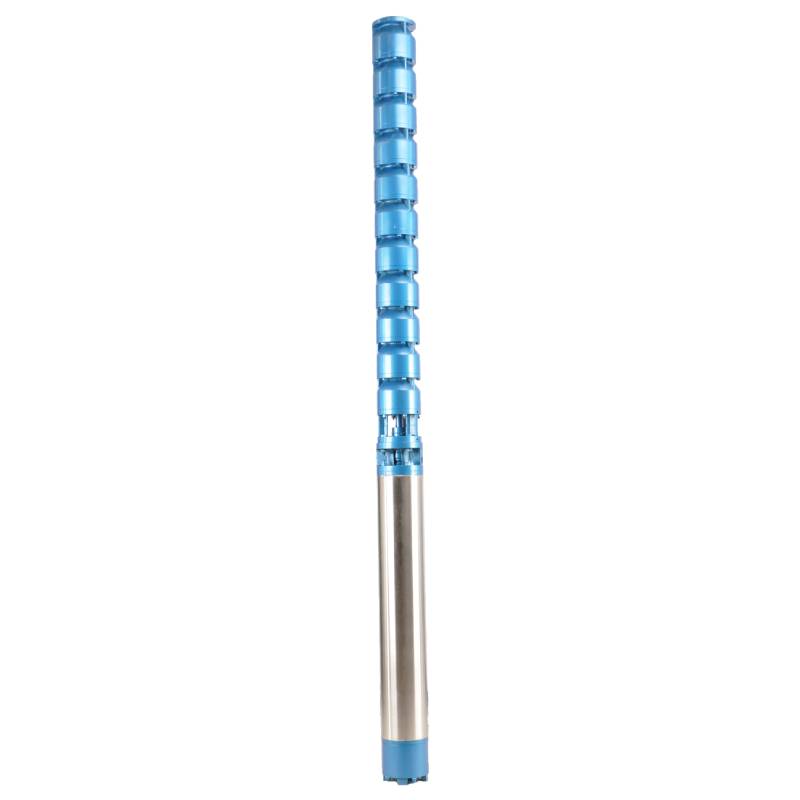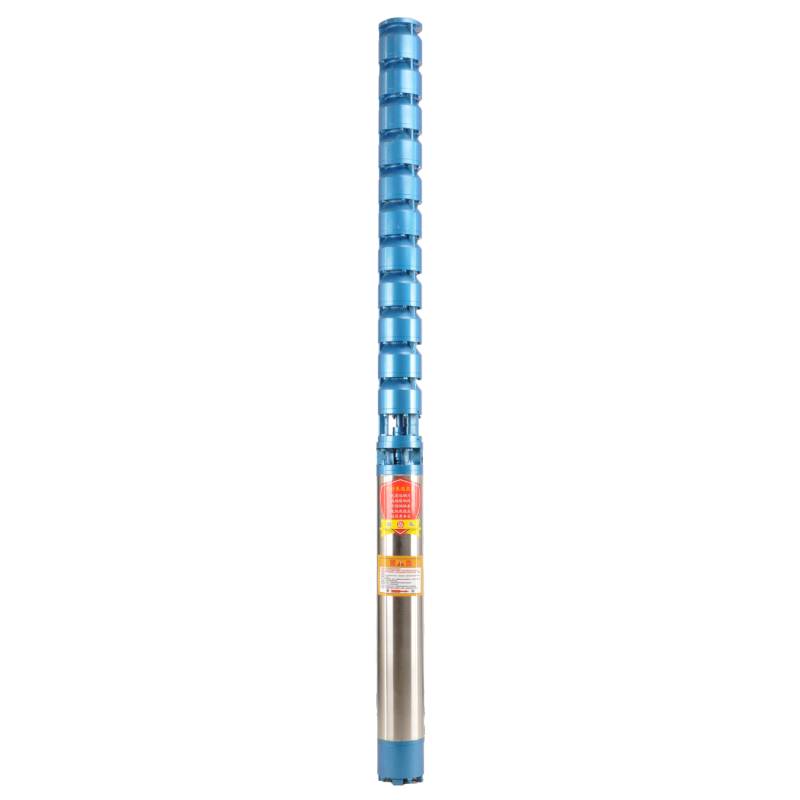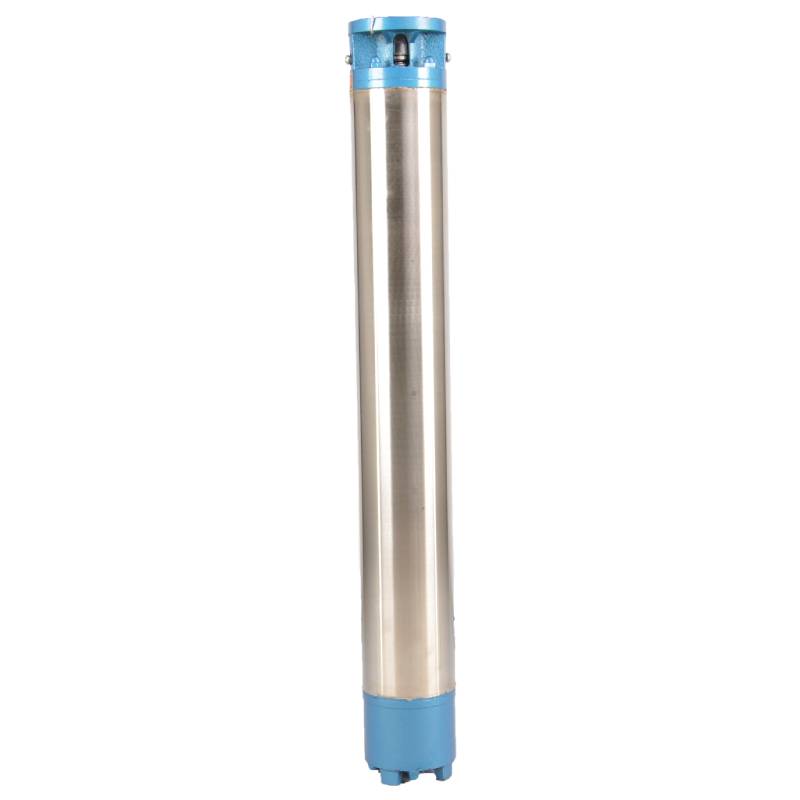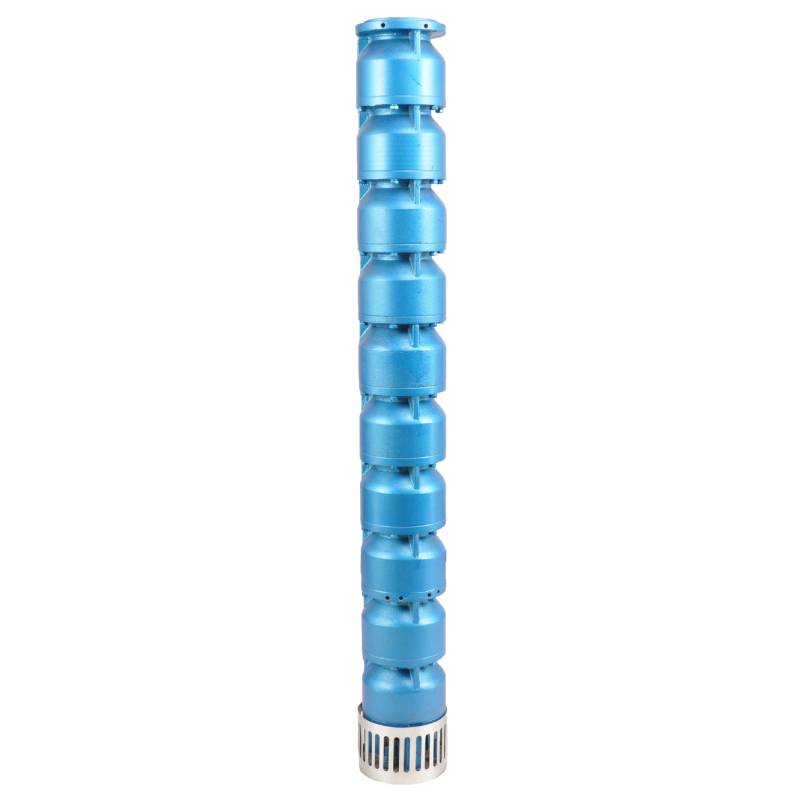Suitable for underground hot water mining with water temperature below 100°C, with heat resistance, corrosion resistance, aging resistance and other characteristics
This product is a powerful three-phase AC 380V (tolerance ± 5%), 50HZ (tolerance ± 1%) electric pump, suitable for all kinds of occasions need high-power pump. Its design considers a variety of water quality factors, including water temperature not higher than 20 °C, solid impurities content is not greater than 0.01%, PH value is 6.5-8.5, hydrogen sulfide content is not greater than 1.5mg/L, chloride ion content is not greater than 400mg/L, etc. The product adopts a closed or water immersion wet structure of the motor, before use in the submersible motor chamber filled with clean water to prevent empty fill. Requirements in strict accordance with the requirements of the matching cable and equipped with external overload protection device. To ensure stable operation, the submersible pump must be completely immersed in water operation, the insertion depth shall not exceed 70 meters, and the distance from the bottom of the well shall not be less than 3 meters. In addition, the pump shall not be a no-load test before start. In general, this product has the characteristics of high efficiency and stability, suitable for a variety of pump tasks in harsh environment.
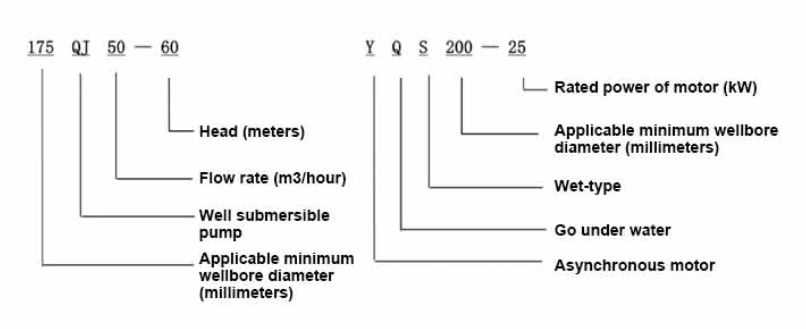
| Modail | Sruth (m3/h) | Ceann (m) |
Luas rothlach (atharrachadh/puing) |
Pumpa uisge (%) | Ar-a-mach trast-thomhas (mm) |
Gu math iomchaidh trast-thomhas (mm) |
Rangaichte cumhachd (KW) |
Rangaichte bholtaids (V) |
Rangaichte sruth (A) |
Èifeachdas motair (%) | power factorcosφ | Aonad Meud radial (mm) |
Facal | |||||||||
| 125QJ5-34 | 5 | 34 | 2850 | 53 | 40 | 125gu h-àrd | 1.5 | 380 | 4.23 | 70.0 | 0.77 | 118 | ||||||||||
| 125QJ5-51 | 51 | 2.2 | 6.03 | 72.0 | 0.77 | |||||||||||||||||
| 125QJ5-68 | 68 | 3 | 8.01 | 73.0 | 0.78 | |||||||||||||||||
| 125QJ5-85 | 85 | 4 | 10.53 | 74.0 | 0.78 | |||||||||||||||||
| 125QJ5-102 | 102 | 5.5 | 14.1 | 75.0 | 0.79 | |||||||||||||||||
| 125QJ5-119 | 119 | 5.5 | 14.1 | 75.0 | 0.79 | |||||||||||||||||
| 125QJ10-24 | 10 | 24 | 2850 | 60 | 50 | 125gu h-àrd | 1.5 | 380 | 4.23 | 70.0 | 0.77 | 118 | ||||||||||
| 125QJ10-32 | 32 | 2.2 | 6.03 | 72.0 | 0.77 | |||||||||||||||||
| 125QJ10-48 | 48 | 3 | 8.01 | 73.0 | 0.78 | |||||||||||||||||
| 125QJ10-56 | 56 | 4 | 10.53 | 74.0 | 0.78 | |||||||||||||||||
| 125QJ10-72 | 72 | 5.5 | 14.1 | 75.0 | 0.79 | |||||||||||||||||
| 125QJ10-80 | 80 | 5.5 | 14.1 | 75.0 | 0.79 | |||||||||||||||||
| 125QJ10-104 | 104 | 7.5 | 19.0 | 76.0 | 0.79 | |||||||||||||||||
| 125QJ10-120 | 10 | 120 | 2850 | 60 | 50 | 125gu h-àrd | 7.5 | 380 | 19.0 | 76.0 | 0.79 | 118 | ||||||||||
| 125QJ10-136 | 136 | 9.2 | 22.7 | 77.0 | 0.8 | |||||||||||||||||
| 125QJ15-36 | 15 | 36 | 2850 | 63 | 50 | 125gu h-àrd | 2.2 | 380 | 6.03 | 72.0 | 0.77 | 118 | ||||||||||
| 125QJ15-39 | 39 | 3 | 8.01 | 73.0 | 0.78 | |||||||||||||||||
| 125QJ15-46 | 46 | 4 | 10.53 | 74.0 | 0.78 | |||||||||||||||||
| 125QJ15-52 | 52 | 4 | 10.53 | 74.0 | 0.78 | |||||||||||||||||
| 125QJ15-59 | 59 | 5.5 | 14.1 | 75.0 | 0.79 | |||||||||||||||||
| 125QJ15-65 | 65 | 5.5 | 14.1 | 75.0 | 0.79 | |||||||||||||||||
| 125QJ15-78 | 78 | 7.5 | 19.0 | 76.0 | 0.79 | |||||||||||||||||
| 125QJ15-91 | 91 | 7.5 | 19.0 | 76.0 | 0.79 | |||||||||||||||||
| 125QJ15-104 | 104 | 9.2 | 22.7 | 77.0 | 0.8 | |||||||||||||||||
| 125QJ20-16 | 20 | 16 | 2850 | 64 | 50 | 125gu h-àrd | 2.2 | 380 | 6.03 | 72.0 | 0.77 | 118 | ||||||||||
| 125QJ20-24 | 24 | 3 | 8.01 | 73.0 | 0.78 | |||||||||||||||||
| 125QJ20-32 | 32 | 4 | 10.53 | 74.0 | 0.78 | |||||||||||||||||
| 125QJ20-40 | 40 | 4 | 10.53 | 74.0 | 0.78 | |||||||||||||||||
| 125QJ20-48 | 48 | 5.5 | 14.1 | 75.0 | 0.79 | |||||||||||||||||
| 125QJ20-56 | 56 | 5.5 | 14.1 | 75.0 | 0.79 | |||||||||||||||||
| 125QJ20-64 | 64 | 7.5 | 19.0 | 76.0 | 0.79 | |||||||||||||||||
| 125QJ20-72 | 72 | 7.5 | 19.0 | 76.0 | 0.79 | |||||||||||||||||
| 125QJ20-80 | 80 | 9.2 | 22.7 | 77.0 | 0.8 | |||||||||||||||||
| 125QJ25-12 | 25 | 12 | 2850 | 64 | 65 | 125gu h-àrd | 2.2 | 380 | 6.03 | 72.0 | 0.77 | 118 | ||||||||||
| 125QJ25-18 | 18 | 3 | 8.01 | 73.0 | 0.78 | |||||||||||||||||
| 125QJ25-24 | 24 | 4 | 10.53 | 74.0 | 0.78 | |||||||||||||||||
| 125QJ25-30 | 30 | 4 | 10.53 | 74.0 | 0.78 | |||||||||||||||||
| 125QJ25-36 | 36 | 5.5 | 14.1 | 75.0 | 0.79 | |||||||||||||||||
| 125QJ25-48 | 48 | 7.5 | 19.0 | 76.0 | 0.79 | |||||||||||||||||
| 125QJ25-60 | 60 | 9.2 | 22.7 | 77.0 | 0.8 | |||||||||||||||||
| 125QJ32-24 | 32 | 24 | 2850 | 64 | 80 | 125gu h-àrd | 4 | 380 | 10.53 | 74.0 | 0.78 | 118 | ||||||||||
| 125QJ32-30 | 30 | 5.5 | 14.1 | 75.0 | 0.79 | |||||||||||||||||
| 125QJ32-42 | 42 | 7.5 | 19.0 | 76.0 | 0.79 | |||||||||||||||||
| 125QJ32-54 | 54 | 9.2 | 22.7 | 77.0 | 0.8 | |||||||||||||||||
| 125QJ5-240 | 5 | 240 | 2850 | 40 | 125gu h-àrd | 11 | 380 | 26.28 | 118 | |||||||||||||
| 125QJ5-280 | 280 | 13 | 30.87 | |||||||||||||||||||
| 125QJ5-320 | 320 | 15 | 35.62 | |||||||||||||||||||
| 125QJ10-180 | 10 | 180 | 2850 | 50 | 125gu h-àrd | 11 | 380 | 26.28 | 118 | |||||||||||||
| 125QJ10-210 | 210 | 13 | 30.87 | |||||||||||||||||||
| 125QJ10-240 | 240 | 15 | 35.62 | |||||||||||||||||||
| 125QJ15-120 | 15 | 120 | 2850 | 50 | 125gu h-àrd | 11 | 380 | 26.28 | 118 | |||||||||||||
| 125QJ15-142 | 142 | 13 | 30.87 | |||||||||||||||||||
| 125QJ15-162 | 162 | 15 | 35.62 | |||||||||||||||||||
| 125QJ20-100 | 20 | 100 | 2850 | 50 | 125gu h-àrd | 11 | 380 | 26.28 | 118 | |||||||||||||
| 125QJ20-120 | 120 | 13 | 30.87 | |||||||||||||||||||
| 125QJ20-136 | 136 | 15 | 35.62 | |||||||||||||||||||
| 125QJ25-82 | 25 | 82 | 2850 | 65 | 125gu h-àrd | 11 | 380 | 26.28 | 118 | |||||||||||||
| 125QJ25-97 | 97 | 13 | 30.87 | |||||||||||||||||||
| 125QJ25-110 | 110 | 15 | 35.62 | |||||||||||||||||||
| 125QJ32-68 | 32 | 68 | 2850 | 80 | 125gu h-àrd | 11 | 380 | 26.28 | 118 | |||||||||||||
| 125QJ32-80 | 80 | 13 | 30.87 | |||||||||||||||||||
| 125QJ32-92 | 92 | 15 | 35.62 | |||||||||||||||||||
| 125QJ40-46 | 40 | 46 | 2850 | 80 | 125gu h-àrd | 11 | 380 | 26.28 | 118 | |||||||||||||
| 125QJ40-54 | 54 | 13 | 30.87 | |||||||||||||||||||
| 125QJ40-62 | 62 | 15 | 35.62 | |||||||||||||||||||
1, well submersible pump for clean water pump, prohibit the new well, pumping sediment and muddy water,
2, well water pump voltage grade of 380/50HZ, the use of other voltage grades of submersible motors need to be customized. The underground cable must use waterproof cable, must be equipped with starting equipment, such as distribution box, start not ready should have commonly used motor comprehensive protection function, such as short circuit overload protection, phase protection, undervoltage protection, grounding protection, idling protection, in case of abnormal conditions, the protection device should be timely action trip.
3, the installation and use of the pump must be reliably grounded, prohibit the push and pull switch when the hands and feet are wet, the installation and maintenance of the pump must be cut off the power supply, the use of the pump place to set up "to prevent electric shock" obvious signs:
4, down the well or before installation, the motor cavity must be filled with distilled water or non-corrosive clean cold boiling water, tighten the / water bolt, the pump on the ground test run, must be to the pump chamber water lubrication rubber bearings, instant start not more than a second, see whether the steering is the same as the steering instructions. When the pump is upright, pay attention to safety, prevent overturning injury.
5, strictly according to the provisions of the pump lift, flow range of use, to prevent low flow or high lift pumping force, the thrust bearing and other parts of the wear, the motor overload burned 6, after the pump down the well, the measurement of the motor to the ground insulation resistance should not be less than 100M, after the start to observe the voltage and current, check the motor winding insulation, whether in line with the requirements; pump storage location temperature if less than freezing point, should be dry the water in the motor cavity, prevent the motor cavity water ice damage caused by low temperature.
The pump parts are mainly composed of pump shaft, impeller, shunt shell, rubber bearing, check valve body (optional) and other components. The motor part is mainly composed of base, pressure regulating diaphragm, thrust bearing, thrust plate, lower guide bearing seat, stator, rotor, upper guide bearing seat, sand discharging ring, water inlet section, lead cable and other components. The motor is a water-filled submersible three-phase asynchronous motor, which is filled with water to cool the motor and lubricate the bearing. The pressure regulating diaphragm at the bottom is used to adjust the difference in internal water expansion and contraction pressure caused by the temperature rise of the motor. In order to prevent the sand in the well water from entering the motor, two oil seals are installed at the upper end of the motor shaft extension, and a sand discharging ring is installed to form a sand discharging structure. In order to prevent the pump shaft from jumping when starting, the pump shaft is connected with the motor shaft through a coupling, and a thrust bearing is installed at the lower part of the motor. The lubrication of the motor and the pump bearing is water lubrication. The stator winding of the motor adopts high quality submersible motor winding wire, with high insulation performance. The pump adopts computer CAD design, with simple structure and excellent technical performance.

(1) Ag ullachadh mus stàladh:
1. Dèan cinnteach a bheil am pumpa fon uisge a’ coinneachadh ris na cumhaichean cleachdaidh agus an raon a tha air a shònrachadh san leabhar-làimhe.
2. A’ cleachdadh inneal trom le trast-thomhas co-ionann ris an trast-thomhas a-muigh as àirde den phump a tha fon uisge, tomhais an urrainn dha trast-thomhas a-staigh an tobair a bhith a’ freagairt air a’ phumpa fon uisge, agus tomhas a bheil doimhneachd an tobair a’ coinneachadh ri riatanasan an stàlaidh.
3. Dèan cinnteach a bheil toll an tobair glan agus a bheil uisge an tobair turbid. Na cleachd pumpa dealain fon uisge gu bràth gus poll pumpa welor agus uisge gainmhich a nighe gus milleadh ro-luath air a’ phump dealain fon uisge a sheachnadh.
4. Dèan cinnteach a bheil suidheachadh a’ chlamp stàlaidh welhead freagarrach agus an urrainn dha seasamh ri càileachd an aonaid gu lèir
5. Dèan cinnteach a bheil na pàirtean pumpa fon uisge coileanta agus air an stàladh ceart a rèir an diagram cruinneachaidh san leabhar-làimhe Thoir air falbh an scrion sìoltachain agus cuairteachadh a’ chàraid gus faicinn a bheil e a ’tionndadh gu sùbailte
6. Unscrew an sgriubha uisge agus lìon a’ chuas motair le uisge glan, neo-chreimneach (nota. bi cinnteach gun cuir thu a-steach e), agus an uairsin teannachadh an sgriubha uisge. Às deidh 12 uair de in-stealladh uisge, cha bu chòir an aghaidh insulation an motair a bhith nas ìsle na 150M Q nuair a thèid a thomhas le clàr crathadh 500V.
7. Cable joint, cut off a 120mm rubber sleeve from one end of the outgoing cable and the matching cable with an electrician's knifethen stagger the length of the three core wires in a stepped shape, peel off a 20mm copper core, scrape of the oxide layer on theoutside of the copper wire with a knife or sand cloth, and insert the two connected wire ends in palirs.After tying the layer tightly with fine copper wire, solder it thoroughly and firmly, and sand of any. burrs on the surface. Then, forthe three joints, use polyvester insulation tape to wrap them in a semi stacked manner for three lavers. Wrap the two ends of thewrapping layer tightywith nyion thread,and then use a semi stacked method to wrap the tape for three layers. Wrap the outellayer with high-pressure insulation tape for three layers. Finally, fold the threestrands together and repeatedly wrap them for fivelayers with high-pressure tape. Each layer must be tightly tied, and the interlayer joints must be tight and fimm to prevent water frompenetrating and damaging the insulation, After wrapping, soak in water at room temperature of 20 ’c for 12 hours, and measurethe insulation resistance with a shaking table, which should not be less than 100M Ω
Tha an diagram pròiseas sreangadh càball ceangailte mar a leanas:
8. Cleachd multimeter gus dèanamh cinnteach a bheil na h-uèirichean trì-ìrean ceangailte agus a bheil an aghaidh DC timcheall air cothromach.
9. Dèan cinnteach a bheil cus luchd air a’ chuairt agus comas an cruth-atharrachaidh, agus an uairsin ceangail an tionndadh dìon cus cuideim no an uidheamachd tòiseachaidh. Faic Clàr 2 airson modalan sònraichte, agus an uairsin dòirt bucaid uisge a-steach don phump uisge bhon ionad pumpa uisge gus na giùlan rubair a lubricadh anns a’ phump, agus an uairsin cuir am pumpa dealain fon uisge gu dìreach agus gu seasmhach.Start (gun a bhith nas fhaide na aon diog). agus dèan cinnteach a bheil an stiùireadh stiùiridh co-chòrdail ris an t-soidhne stiùiridh. Mura h-eil, suaip dà cheangail den chàball trì-ìre.Then stàlaich an criathrag agus ullaich airson a dhol sìos an tobar. Ma thèid a chleachdadh aig amannan sònraichte (leithid dìgean, dìgean, aibhnichean, lochan, lòin, msaa), feumaidh am pumpa dealain a bhith air a chuir air bhonn gu h-earbsach.
(2) Uidheam agus innealan stàlaidh:
1. Aon phaidhir de shlabhraidhean togail airson barrachd air dà thunna.
2. Tripod le àirde dìreach nach eil nas lugha na ceithir meatairean.
3. Dà ròp crochte (ròpaichean uèir) as urrainn cuideam nas motha na aon tunna a ghiùlan (faodaidh cuideam seata iomlan de phumpaichean uisge a ghiùlan).
4. Stàlaich dà phaidhir de clamps (splints).
5. Wrenches, ùird, screwdrivers, innealan dealain agus ionnstramaidean, msaa.
(3) Stàladh pumpa dealain:
1. Tha an diagram stàlaidh den phump dealain submersible air a shealltainn ann am Figear 2. Tha na tomhasan stàlaidh sònraichte air an sealltainn ann an Clàr 3 "Liosta de mheudan stàlaidh a' phump dealain fon uisge".
2. Faodar pumpaichean dealain fon uisge le ceann nas lugha na 30 meatair a thogail gu dìreach a-steach don tobar le bhith a’ cleachdadh phìoban agus ròpaichean uèir no ròpannan hemp eile as urrainn làn chuideam an inneil gu lèir, pìoban uisge, agus uisge anns na pìoban a ghiùlan.
3. Bidh pumpaichean le ceann nas motha na 30 meatair a 'cleachdadh pìoban stàilinn, agus tha an sreath stàlaidh mar a leanas:
① Cleachd clamp gus ceann shuas pàirt a’ phump uisge a chlampadh (tha am pumpa motair is uisge air a cheangal aig an àm seo), tog e le slabhraidh crochte, agus ceangail gu slaodach a-steach don tobar gus an cuir thu an clamp air ceann an tobair agus thoir air falbh an slabhraidh crochte.
② Cleachd paidhir clamps eile gus pìob a chlampadh, tog e le slabhraidh crochte 15 cm air falbh bhon flange, agus lughdaich e gu slaodach. Eadar flange pìoba agus flange pumpa Cuir am pasgan rubair na àite agus teannachadh a’ phìob agus am pumpa gu cothromach le boltaichean, cnothan agus nigheadairean earraich.
③ Tog beagan am pumpa fon uisge, thoir air falbh an clamp air ceann shuas a’ phump uisge, ceangail an càball gu daingeann ris a’ phìob uisge le teip plastaig, agus ceangail sìos e gu slaodach gus an tèid an clamp a chuir aig ceann an tobair.
④ Cleachd an aon dòigh airson a h-uile pìob uisge a cheangal a-steach don tobar.
⑤ Às deidh don chàball luaidhe a bhith ceangailte ris an suidse smachd, tha e ceangailte ris an t-solar cumhachd trì ìrean.
(4) Rudan ri thoirt fa-near aig àm an stàlaidh:
1. Ma lorgar iongantas jamming tron phròiseas pumpaidh, tionndaidh no tarraing am pìob uisge gus faighinn thairis air a’ phuing jamming. Mura h-eil grunn cheumannan ag obair fhathast, feuch nach toir thu air a’ phump sìos gus milleadh a sheachnadh air a’ phump dealain fon uisge agus an tobar.
2. Rè an stàladh, bu chòir ceap rubair a chuir aig flange gach pìoba agus a theannachadh gu cothromach.
3. Nuair a thèid am pumpa uisge a leigeil a-steach don tobar, bu chòir a chuir ann am meadhan pìob an tobair gus casg a chuir air a ’phump bho bhith a’ ruith an-aghaidh balla an tobair airson ùine mhòr, ag adhbhrachadh gum bi am pumpa a ’crith agus an motair a’ sguabadh agus a losgadh .
4. Obraich a-mach doimhneachd a' phump uisge gu bonn an tobair a rèir suidheachadh gainmhich is eabar an tobair. Na cuir a-steach am pumpa san eabar. Mar as trice chan eil an astar bhon phump uisge gu bonn an tobair nas lugha na 3 meatairean (faic Figear 2).
5. Cha bu chòir doimhneachd inntrigidh uisge a’ phump uisge a bhith nas lugha na 1-1.5 meatairean bhon ìre uisge fiùghantach chun nód uisge a-steach (faic Figear 2). Rud eile, dh ’fhaodadh na giùlan pumpa uisge a bhith air am milleadh gu furasta.
6. Chan urrainn togail a' phump uisge a bhith ro ìosal. Rud eile, feumar bhalbhaichean geata a chuir a-steach air loidhne-phìoban uisge ceann an tobair gus smachd a chumail air sruthadh a’ phump aig a’ phuing sruthadh ìre gus casg a chuir air a’ motair a bhith air a luchdachadh cus agus a losgadh a-mach air sgàth ìrean sruth mòr.
7. Nuair a bhios am pumpa uisge a 'ruith, bu chòir an toradh uisge a bhith leantainneach agus eadhon, bu chòir an sruth a bhith seasmhach (fo chumhachan obrach comharraichte, mar as trice gun a bhith nas fhaide na 10% den t-sruth), agus cha bu chòir crith no fuaim a bhith ann. Ma tha ana-cainnt sam bith ann, bu chòir stad a chuir air an inneal gus faighinn a-mach an adhbhar agus cuir às dha.
8. Nuair a bhios tu a’ stàladh, thoir aire do shuidheachadh an uèir talmhainn motair (faic Figear 2). Nuair a tha am pìob uisge na phìob stàilinn, stiùir e bhon chlamp ceann tobair; nuair a tha am pìob uisge na phìob plastaig, stiùir e bho chomharra bunaiteach a’ phump dealain.
- (1)With the continuous development of modern technology, submersible pumps play a crucial role in the field of pumps. After installing the submersible pump, check the insulation resistance and three-phase continuity repeatedly to ensure that there are no errors in the connection between the instrument and the starting equipment. If everything is normal, the test equipment can be started. After starting, observe whether the indication readings of each instrument are correct. If the rated voltage and current specified on the nameplate are exceeded, pay attention to observe whether the pump has any noise or vibration. If everything is normal, it can be put into operation. After the pump runs for four hours for the first time, it should be closed and the thermal insulation resistance of the motor should be tested quickly, and its value should not be less than 0.5 megaohms. After stopping the pump, restart it after five minutes to prevent the water column in the pipeline from completely reversing, resulting in the motor burning due to overcurrent. After the pump is running normally, in order to prolong its service life, it is necessary to check regularly whether the supply voltage, working current and insulation resistance are normal. If the following conditions are found, the equipment should be shut down immediately to troubleshoot. The current exceeds 20% under the rated working conditions; the dynamic water level drops to the inlet section, resulting in intermittent drainage; the submersible pump vibrates violently or makes noisy sounds; the supply voltage is lower than 340 volts; any fuse is broken; the water pipe is damaged; The thermal insulation resistance between the motor and the ground is less than 0.5 megaohm.These recommended operating procedures and safety measures ensure the safe operation of the submersible pump, prolong the service life of the equipment, and provide users with a reliable pump choice.
- (2)Unit disassembly:
- 1 untie the cable tie, remove the pipeline part, remove the wire plate.
- 2 unscrew the water release bolt, put the water in the motor chamber.
- 3 remove the filter, loose the fixing screw of the motor shaft on the coupling.
- 4 unscrew the bolt connecting the water inlet section with the motor, and separate the pump from the motor (pay attention to the unit cushion when separating, to prevent the bending of the pump shaft)
- 5 the disassembly sequence of the pump is: (see figure 1) water inlet section, impeller, diversion shell, impeller...... check valve body, when removing the impeller, use special tools to loosen the conical sleeve of the fixed impeller first, and avoid bending the pump shaft and various bumps in the disassembly process.
- 6 the disassembly process of the motor is: (see figure 1) place the motor on the platform, and remove the nut, base, shaft head lock nut, thrust plate, key, lower guide bearing seat, double head bolt from the bottom of the motor in turn. Then take out the rotor (pay attention not to damage the wire package) and finally remove the connecting section and upper guide bearing seat.
- 7 unit assembly: Before assembly, the rust and dirt of the parts should be cleaned, and the mating surfaces and fasteners should be coated with sealant. Then they should be assembled in the reverse order of disassembly (the up and down momentum of the motor shaft is about 1 mm after assembly). After assembly, the coupling should be flexible, and then the filter screen test machine.
- (3)The submersible pump should be dismantled and repaired according to Article 5 for each operation year, or less than one year, but the submersible time has reached two years, and the worn parts should be replaced.
1, cuir a-mach an uisge anns a’ chuas motair (gu sònraichte sa gheamhradh gus casg a chuir air an motair bho reothadh), agus ceangail an càball gu math.
2, store in an indoor room without corrosive substances and gases, with a temperature below 40 °C.
3, bu chòir cleachdadh fad-ùine aire a thoirt do chasg meirge bho phumpaichean fon uisge.
- Impeller
- Muinchille shaft
- Muinchill rubair
-
Cearcall ròin
01 Tobar uisge domhainn
02 Solar uisge àrd
03 solar uisge beinne
04 tùr uisge
05 Uisgeachadh àiteachais
06 uisgeachadh gàrraidh
07 toirt a-steach uisge aibhne
08 uisge dachaigheil

